by Claudio
Morelli and Giorgio Busetto
if you like this page, support ASCAS clicking on the +1 button of google
(click on photos to enlarge image)
FIVE CENTURIES OF NEAPOLITAN SILVER MARKS
The use of the marking of silver in Naples
dates back to the fourteenth century during the
reign of Joanna I of Anjou. The first official
documentation of this practise dates back only to
1437 and is the privilege issued to goldsmith Paolo
di Roma by King Alfonso of Aragon.
Over the following centuries the Goldsmiths'
Corporation became very powerful, so that the
Viceroy Count of Sant'Esteban, August 19, 1690,
promulgated "The Pragmatic De Monetis LVII.". This
Law imposed the concentration in Naples of all
activities involving the processing of precious
metals and the use of 833.33/1000 fineness.
(on the right) Portrait of Joanna of Anjou, the
First Queen of Naples from 1343 to 1381
|
 |
To ensure the quality of the metal the objects were punched
with:
1) mark of silversmiths' guild
2) initials of the name and surname of the alderman with the
addition of a "C"
3) initials of the master silversmith (or the full surname,
especially in the 19th century).
THE GUILD OF SILVERSMITHS MARK
The Guild's mark consisted until to 1690 in the abbreviation "NAP"
or "NAPL" or "NA" (the latter only from 1680) surmounted by a
crown.
From 1690 to 1699 under the abbreviation of Naples have been
added the last two digits of the year.
Since 1700, the date has been indicated by including the last
three digits of the year. However, some exceptions are known,
1729 - 1732 - 1735, when the year was indicated in four digits.
These punches, as well as the date, differ also in the shape of
the crown and remained in use until 1808.
 |
 |
 |
 |
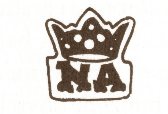 |
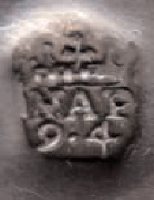 |
c. 1437
|
c. 1465
|
16th century
|
1619 / 1680 c.
|
1680 / 1690
|
1694
|
 |
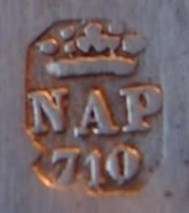 |
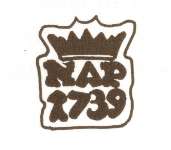 |
 |
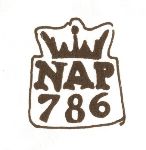 |
 |
1702
|
1710
|
1739
|
1745
|
1786
|
1808
|
THE ALDERMAN MARK
The alderman used a mark with the initials of his name followed
by the letter "C" (meaning "Console").
This punch was of rectangular shape until the end of the 17th
century (the last was that of Marcantonio Di Benedetto elected
"console" in August 1700).
Later, the punch was of various forms: square, round, oval,
roughly triangular, hexagonal. In almost all cases, however, the
letter "C" was on a separate line (below the initials of the
"console")
 |
 |
 |
 |
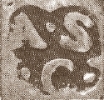 |
 |
Domenico
Mazzola
c. 1588
|
Salvo
Gambardella
c. 1605
|
Melchiorre
Maturano
1653-1683
|
Giuseppe
Cangiani
1690
|
Aniello
Simioli
1713
|
Nicola
Della Noce
1700
|
 |
 |
 |
 |
 |
 |
G.Battista
D'Aula
1702
|
Domenico Antonio
Guariniello
1719
|
Gennaro
De Blasio
1740
|
Nicola
De Blasio
1750
|
Aniello
Guariniello
1753
|
Giuseppe
Guariniello
1757
|
THE SILVERSMITH'S MARK
The silversmith used a punch with the initials of his name and
surname. The initials were on a single or on two lines inside a
simple contour (often rectangular). In the 19th century, in some
cases, the silversmith used a mark with his full name.
The use of marks with the illustrated symbol of the workshop,
widespread in most other Italian regions, was not followed in
Naples.
 |
 |
 |
 |
Andrea Blasio
18th century
|
Angelo De Luca
18th century
|
Giovanni Casolla
19th century
|
Gennaro Iaccarino
19th century
|
THE FRENCH DOMINATION
With the Napoleonic invasion of the Kingdom of Naples the new
rulers (Joseph Bonaparte, 1805 - 1808, and Joachim Murat, 1808 -
1815) fully reformed the activities related to the gold and
silver manufacture.
The Guilds were abolished, any activity was liberalized, the
decimal system was adopted introducing the organizational model
active in France since 1797 (Law 9 Brumaire, Year VI - November
9, 1797).
The Law n. 242 of December 17, 1808 established new purity
degrees for gold and silver. Two levels of fineness were
admitted for silver: 917/000 and 834/000. Each piece was punched
with:
· warranty mark;
· assayer mark;
· maker's mark
The warranty mark depicts a female bust and represents the
mythical siren Parthenope. Aside this mark was applied an Arabic
numeral ranging from one to five. The numbers 1, 2 and 3 were
used for gold, while 4 and 5 indicated respectively 917/000 and
834/000 silver fineness.
 |

 |
1st silver fineness
mark 917/000
|
2nd silver fineness
mark 834/000
|
This hallmarking system was maintained in use until 1823,
well beyond the end of the French occupation (1815).
Other marks used during the "French" period were a "V" and an
"S" (coupled with "4" or "5"). In the literature examined the
use and nature of these punches is controversial.
Some authors (Ugo Donati and Donaver-Dabbene) report the "S" as
the symbol used to mark the imported silver and the "V" that
used for "old" silver. In contrast, Elio and Corrado Catello do
not mention the hallmarking of foreign silver and attribute the
mark "S" to "old" silver.
FROM THE "KINGDOM OF THE TWO SICILIES" TO THE "KINGDOM OF
ITALY"
1824-1832
Following the presence of numerous false dies, King Ferdinand I,
on December 15, 1823 (decree No 881), introduced new marks for
precious metal and abolished those in use since the French
domination.
The new mark depicted the head of Parthenope guardant towards
right with aside the number indicating the fineness or the "E"
(Estero) for imported silver. The silver fineness was
represented by the Arabic numerals:
· 7 for 916/000 or 11 ounces
· 8 for 833/000 or 10 ounces
 |
 |
 |
1st silver fineness
mark 917/000
|
2nd silver fineness
mark 834/000
|
mark for
imported silver
|
1832-1872
With Decree No 723, January 26, 1832, to further differentiate
the domestic from foreign production, the marks were modified
adding to the profile of Parthenope the letter "N" for domestic
("Nostrale") or the letter "E" for foreign silver ("Estero").
 |
 |
 |
 |
Domestic silver
917/000
|
Domestic silver
834/000
|
Foreign silver
917/000
|
Foreign silver
834/000
|
1839-1872
With Decree No 5207 March 4, 1839 was introduced a special mark
for worship objects dedicated to the religious service. This
mark used the symbol of the "Cross" instead of the female
profile.
 |
 |
Religious silver
fineness 917/000
|
Religious silver
fineness 834/000
|
Naples became part of the Kingdom of Italy in 1860, but
maintained its previous hallmarking system until 1872.
The law May 2, 1872 issued by Vittorio Emanuele II King of Italy
liberalized the production of precious metals. Only an optional
and voluntary control was provided for the verification of
silver fineness.
 |
 |
 |
1st silver
fineness
950/000
|
2nd silver
fineness
900/000
|
3rd silver
fineness
800/000
|
NAPLES: BRIEF HISTORICAL CRONOLOGY
The Kingdom of Naples, comprising the southern part of the
Italian peninsula, was the remainder of the old Kingdom of
Sicily after secession of the island of Sicily as a result of
the Sicilian Vespers rebellion of 1282.
Known to contemporaries as the Kingdom of Sicily, it is dubbed
Kingdom of Naples to distinguish it from the island-based polity.
During much of its existence, the realm was contested between
French and Aragon's/Spanish dynasties.
In 1806, following decisive victories over the allied armies at
Austerlitz and over the Neapolitans at Campo Tenese, Napoleon
installed his brother, Joseph as King of Naples. When Joseph was
sent off to Spain two years later, he was replaced by Napoleon's
sister Caroline and his brother-in-law Marshal Joachim Murat, as
King of the Two Sicilies.
In 1816, after the defeat of Napoleon, Ferdinand IV of Bourbon
was restored to the throne of Naples merging with island-based
Kingdom of Sicily to form the Kingdom of the Two Sicilies.
In 1860 Naples and the territories of the Kingdom of the Two
Sicilies became part of the Kingdom of Italy.
(based on information by Wikipedia.org)
Claudio Morelli and Giorgio Busetto
- 2011 -
|
|
|

